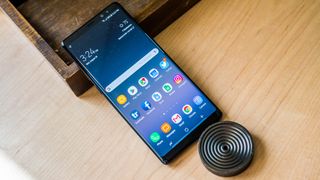Even in 2018, the Galaxy Note 8 remains the biggest reimagining of Samsung’s best smartphones for productivity, and more than enough to right the major wrongs of the recalled Note 7. This is a mega-sized mea culpa.
After all of our hands on time with the Note 8 has has us convinced: this is a true redesign of not just the Note series, but of the average smartphone from top-to-bottom, edge-to-edge, and rear camera to, well, rear camera. There are now two cameras on the back, a first for a Samsung flagship smartphone (the new S9 Plus has it too). It takes brilliant portrait photos, and you can even edit the depth of field post-capture.
What makes the Note 8 different is the handy S Pen stylus and larger 6.3-inch ‘Infinity Display’ to work with – but one that doesn’t increase the dimensions of the actual phone too much. The phone acts like a big, borderless glass canvas for your important handwritten notes and masterpiece doodles.
Watch our video review of the Samsung Galaxy Note 8 below.
Why buy this instead of the new 6.2-inch Galaxy S9 Plus? The extra tenth of an inch of screen is insignificant and doesn’t matter, but Note fans adore the S Pen stylus functionality and its more square shape. Over the S8 Plus, the Note 8 also benefits power users with 6GB or RAM a superior dual-lens camera, both features passed on to the S9 Plus.
This is the most powerful Samsung phone with a stylus yet. It does, however, cost you in three ways. First, it’s too big for some – it’s technically one of Samsung’s best, but not the best for everyone. You’re going to need a Note 8 case to confidently hold this unwieldy glass beast, and two hands to operate it.
Second, the big screen also comes at the cost of the Note’s usual oval-shaped fingerprint sensor home button. It’s gone. The on-screen button that replaces it works fine, but the fingerprint sensor is now located on the back of the device and off-center – it’s a textbook flawed design, and the alternative iris scanner doesn’t always work when you want to unlock the phone. We're hoping the Galaxy Note 9 fixes this in a couple of months.

Then there’s the Note 8 price. If you want top-of-the-line specs, the one of the most advanced cameras, a stunning display, and streamlined multitasking on a phone, you’re really going to pay for them. The Note 8 costs more than the S8 Plus, although if you’re going to sink a lot of money into a device that you use everyday, you may as well go all the way.
Can your wallet, and the extent of your grip, handle the Note 8? That’s pretty much all that you – if you have faith in Samsung again – need to ask yourself before buying this phone.
The new Google Pixel 2 and Pixel 2 XL are the biggest Samsung Galaxy Note 8 rivals. They already run Android Oreo and Google's camera is slightly better but its screen colors are worse, in our opinion. The Google Pixel 2 XL is having a few screen burn-in problems, too. Apple has the all-new iPhone X with a borderless display, facial recognition and an equally sizable price tag, but that requires switching over from Android to iOS 11. That's a tough sell.
The Note 8 rules supreme in the big-screen, big-power, big-price arena, as we'll demonstrate in our full review.
Price and release date
- At $929 (£869, AU$1,499), it's the most expensive (non-Apple) phone you'll buy
- Released on September 15 in US and UK, September 22 in Australia
The Galaxy Note 8 release date was Friday, September 15 in the US and UK, while Australia got the new phone on September 22. It's readily available.
The official Note 8 price is $929 (£869, AU$1,499), and US carriers have it for as much as $40 a month for 24 months, though we’d suggest getting the unlocked, carrier-agnostic version. You can find it cheaper via Amazon US or eBay.
Advertisement
Either way, it’s going to be the most expensive smartphone you’ve ever bought. The Galaxy S8 Plus, for comparison, cost $829 (£779, AU$1,349) at launch, but you can now get Plus for around $699 in the US, while Galaxy S8 deals make the smaller version almost half the price of the Note 8.
Good news, though: you can already find Galaxy Note 8 deals in the US and also in the UK. At launch in the US, it came with either a free Gear 360 camera or a 128GB memory card and fast wireless charger. We expect similar repeat deals.
In the UK the freebie was a DeX docking station, and there’s a dual-SIM version available. T-Mobile offers a $200 rebate.
Design and display
- 6.3-inch 'Infinity Display' redefines the Note look and feel
- But it's 9mm taller than any Note phone – it's the new big
- Water-resistant up to 1.5m (5ft) for 30 minutes
- The best color, Deep Sea Blue, only just launched in the US
The Note 8 maximizes Samsung’s dual curved edge and nearly bezel-less Infinity Display to the point where this phone feels like a mini tablet from the future. It’s impressive-looking, but also big and heavy – 9mm taller than any previous Note phone, and 195g.

Advertisement
Stretching your fingers is well worth if you can physically manage it. Its expansive 6.3-inch display – now without a physical home button – has an unheard-of 83% screen-to-body ratio. The iPhones have a 67% screen-to-body ratio for comparison. That's a lot less screen for such big phones, at least until iPhone 8 arrives to change everything.
Samsung keeps topping itself, launching phones with the world’s best display every six months. Its maximum brightness, 3K resolution with Mobile HDR Premium, and wider color gamut are hard for anyone else to compete with. It's Always-On Display continues to be an appealing feature in a smartphone.
Lit up, the all-screen Note 8 feels like we’re carrying around a piece of light when we’re out and about. It's much better than the Pixel 2 and Pixel 2 XL display, Google's biggest weakness.
The entire front glows with unimpeded information – as long as you don’t drop and crack it, and you’ll need to be extra careful as the entire phone is enveloped in glass wrapped around an aluminum frame. Combined with its size, this makes for one slippery smartphone.
While we spent most of the time using this phone naked (that’s without a case), we did test several Note 8 cases and instantly felt more confident carrying it around. Why? The added grip (and peace of mind) let us operate it with one hand, whereas we struggled with the pure glass body at such tall and wide dimensions. Sorry – you’re going to need a case with this phone.





No comments: